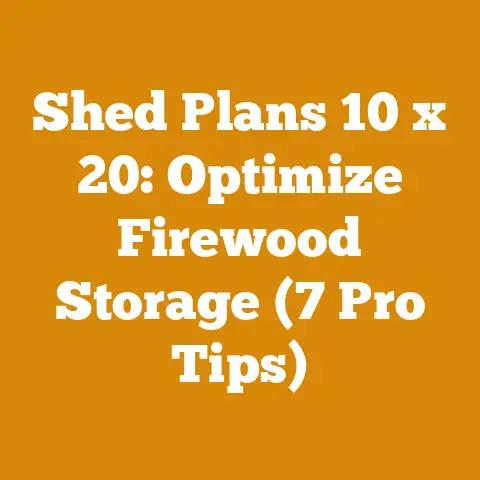At What Temperature Will Wood Ignite? (Essential Guide for Woodworkers)
At What Temperature Will Wood Ignite? (Essential Guide for Woodworkers)
The question “At what temperature will wood ignite?” seems straightforward, but the answer is multifaceted. It’s not a single temperature; rather, it’s a range influenced by various factors. Generally, wood will ignite around 300°C (572°F) under specific laboratory conditions. However, this is just the beginning of the story.
Spontaneous Ignition vs. Piloted Ignition
Before diving deeper, it’s crucial to understand the two primary types of ignition: spontaneous (or auto-ignition) and piloted ignition.
- Spontaneous Ignition: This occurs when wood reaches a high enough temperature to ignite without an external flame or spark. The wood essentially heats up internally until it bursts into flames.
- Piloted Ignition: This happens when wood is exposed to an external ignition source, such as a flame or spark. This is the more common scenario in woodworking and fireplace settings.
The temperature for spontaneous ignition is typically higher than that for piloted ignition. For piloted ignition, wood can ignite at temperatures as low as 200°C (392°F) if exposed to a sustained flame.
Factors Influencing Wood Ignition Temperature
Numerous factors can significantly alter the temperature at which wood ignites. These factors can be broadly categorized into wood properties, environmental conditions, and the nature of the ignition source.
Wood Properties
- Wood Species: Different wood species have varying densities and chemical compositions, which directly affect their ignition temperatures. For instance, hardwoods like oak and maple generally require higher temperatures to ignite than softwoods like pine and fir. This is due to the denser structure and higher lignin content in hardwoods.
- Moisture Content: Moisture is a significant deterrent to ignition. Wet wood requires considerably more energy to ignite because the water must first evaporate before the wood can reach its ignition temperature. As a rule of thumb, every 1% increase in moisture content increases the ignition temperature slightly.
- Density: Denser woods tend to ignite at higher temperatures because they have more mass to heat. However, once ignited, they also tend to burn longer and hotter.
- Size and Shape: The surface area-to-volume ratio plays a crucial role. Thin, small pieces of wood ignite more easily because they heat up faster. Large, thick logs take longer to reach ignition temperature.
- Chemical Treatments: Wood treated with fire retardants has a significantly higher ignition temperature. These chemicals alter the wood’s composition, making it more resistant to burning.
Environmental Conditions
- Ambient Temperature: The surrounding temperature affects how quickly wood reaches its ignition point. In a cold environment, more energy is needed to raise the wood’s temperature to the ignition point.
- Airflow: Oxygen is a critical component of combustion. Increased airflow provides more oxygen, which can lower the effective ignition temperature. This is why kindling is crucial for starting a fire; its small size and ample airflow make it easy to ignite.
- Humidity: High humidity can increase the moisture content of wood, making it harder to ignite. Conversely, dry air can lower the wood’s moisture content, making it easier to ignite.
Ignition Source
- Type of Flame: The temperature and intensity of the ignition source matter. A small spark might not be enough to ignite a large piece of wood, while a blowtorch will ignite it quickly.
- Duration of Exposure: Prolonged exposure to a heat source, even at a lower temperature, can eventually lead to ignition. This is why slow pyrolysis (heating wood in the absence of oxygen) can eventually lead to charcoal production.
- Direct vs. Indirect Heat: Direct flame contact is more effective at initiating ignition than indirect radiant heat.
Measuring Wood Ignition Temperature: Methods and Challenges
Determining the exact ignition temperature of wood is a complex process, often performed in controlled laboratory settings.
Standard Testing Methods
- ASTM E119: This standard test method is used to determine the fire resistance of building materials, including wood. It involves exposing a sample to a standardized fire and measuring the time it takes for the sample to fail.
- Cone Calorimeter: This device measures the heat release rate of a material when exposed to radiant heat. It’s used to assess the flammability of wood and other materials.
- Differential Scanning Calorimetry (DSC): DSC is a technique used to measure the heat flow associated with transitions in materials as a function of temperature. It can be used to determine the temperatures at which wood starts to decompose and ignite.
Challenges in Measurement
- Variability of Wood: Natural variations in wood species, density, and moisture content make it difficult to obtain consistent results.
- Influence of Environmental Factors: Controlling environmental conditions, such as temperature and humidity, during testing is challenging.
- Defining Ignition: Precisely defining when ignition occurs can be subjective. Is it when the first small flame appears, or when sustained combustion begins?
Practical Implications for Woodworkers and Homeowners
Understanding the ignition temperature of wood has significant practical implications for woodworking, home safety, and firewood management.
Woodworking Safety
- Preventing Sawdust Fires: Sawdust is highly flammable due to its fine particle size and large surface area. Proper dust collection systems are essential to prevent sawdust from accumulating and potentially igniting.
- Safe Disposal of Oily Rags: Linseed oil and other finishes can spontaneously combust when rags are improperly stored. Always spread oily rags out to dry in a well-ventilated area or store them in a tightly sealed metal container filled with water.
- Controlling Heat from Power Tools: Power tools can generate significant heat, especially when used for prolonged periods. Avoid overheating the wood by using sharp blades and taking frequent breaks.
I remember one time when I was working on a large oak project, I left a pile of sawdust near a halogen work light. When I returned after lunch, I was shocked to find the sawdust smoldering. Luckily, I caught it in time, but it was a stark reminder of how easily sawdust can ignite.
Firewood Management
- Proper Storage: Store firewood away from your home and other structures to reduce the risk of fire spread. Keep it covered to prevent it from getting wet, which can promote mold growth and reduce its heating value.
- Seasoning Wood: Seasoning wood (drying it out) reduces its moisture content, making it easier to ignite and burn efficiently. Properly seasoned firewood produces more heat and less smoke.
- Safe Fire-Starting Practices: Use kindling and tinder to start fires, and avoid using flammable liquids. Never leave a fire unattended.
I’ve always made sure to season my firewood for at least six months before burning it. Not only does it burn hotter and cleaner, but it also reduces the risk of creosote buildup in my chimney, which is a major fire hazard.
Home Safety
- Chimney Maintenance: Regular chimney cleaning is essential to remove creosote, a flammable substance that can accumulate in chimneys and cause chimney fires.
- Smoke Detectors: Install smoke detectors on every level of your home and test them regularly.
- Fire Extinguishers: Keep fire extinguishers readily accessible and know how to use them.
Cost Factors in Wood Processing and Firewood Preparation
Understanding the costs involved in wood processing and firewood preparation is crucial for budgeting and maximizing efficiency. These costs can be broken down into several categories: material costs, labor costs, tool costs, and miscellaneous expenses.
Material Costs
-
Timber Purchase or Harvesting Costs: The cost of raw timber varies widely depending on the species, quality, and location. Purchasing timber from a lumberyard is generally more expensive than harvesting it yourself, but it also saves time and effort.
- Data Point: According to the USDA Forest Service, the average stumpage price (the price paid for standing timber) for sawtimber in the Southern United States in 2022 was around \$300 per thousand board feet.
-
Firewood Purchase Costs: The price of firewood depends on the type of wood, the quantity purchased, and the location. Firewood is typically sold by the cord, which is a stacked pile of wood measuring 4 feet high, 4 feet wide, and 8 feet long (128 cubic feet).
-
Data Point: The average price of a cord of seasoned firewood in the United States in 2023 ranged from \$200 to \$400, depending on the region and wood species.
- Cost of Firewood Permits: In some areas, you may need a permit to collect firewood from public lands. The cost of these permits varies depending on the location and the amount of wood you plan to collect.
I’ve found that buying timber in bulk during the off-season can often save money. Lumberyards are often willing to offer discounts to clear out inventory.
Labor Costs
-
Logging Crew Wages: If you’re hiring a logging crew to harvest timber, labor costs can be a significant expense. Wages vary depending on the location, the size of the crew, and the complexity of the job.
- Data Point: The average hourly wage for loggers in the United States in 2023 was around \$22 per hour, according to the Bureau of Labor Statistics.
- Firewood Handlers’ Wages: If you’re paying someone to split and stack firewood, labor costs can add up quickly. Consider hiring someone on a per-cord basis to control costs.
- Personal Time: Don’t forget to factor in the value of your own time when calculating the cost of wood processing or firewood preparation. Even if you’re not paying yourself an hourly wage, your time has value.
I once hired a logging crew to clear a section of my property. I underestimated the labor costs and ended up spending far more than I had budgeted. Now, I always get multiple quotes and carefully review the scope of work before hiring anyone.
Tool Costs
-
Chainsaw Purchase and Maintenance: Chainsaws are essential tools for wood processing and firewood preparation. The cost of a chainsaw depends on its size, power, and features. Regular maintenance, such as sharpening the chain and replacing worn parts, is also necessary.
- Data Point: A professional-grade chainsaw can cost anywhere from \$500 to \$1500, while a homeowner-grade chainsaw can cost from \$200 to \$500.
-
Wood Splitter Purchase or Rental: Wood splitters can significantly reduce the time and effort required to split firewood. You can either purchase a wood splitter or rent one.
-
Data Point: A hydraulic wood splitter can cost from \$1000 to \$4000, while renting one typically costs around \$50 to \$100 per day.
- Logging Tools (Axes, Saws, Skidding Equipment): Other logging tools, such as axes, saws, and skidding equipment, can also add to the overall cost.
- Safety Gear (Helmets, Gloves, Eye Protection): Safety gear is essential for protecting yourself from injury. Don’t skimp on safety gear.
I’ve learned that investing in high-quality tools pays off in the long run. A good chainsaw, for example, will last longer and perform better than a cheap one. Plus, it’s safer to use.
Miscellaneous Expenses
- Fuel and Oil: Chainsaws and wood splitters require fuel and oil. The cost of fuel and oil can add up quickly, especially if you’re processing a lot of wood.
- Permits and Licenses: In some areas, you may need permits or licenses to harvest timber or sell firewood.
- Transportation Costs: Transporting timber or firewood can be expensive, especially if you’re hauling it long distances.
- Equipment Rental Fees: If you’re renting equipment, such as a wood splitter or a skidder, factor in the rental fees.
- Storage Costs: Storing firewood can require space and may incur costs if you’re renting storage.
Budgeting and Cost Management Strategies
Effective budgeting and cost management are essential for maximizing profitability in wood processing and firewood preparation.
Detailed Cost Breakdown
Start by creating a detailed cost breakdown that includes all of the expenses mentioned above. This will give you a clear picture of where your money is going.
Price Negotiation
Negotiate prices with suppliers and contractors. Don’t be afraid to ask for discounts or shop around for better deals.
Efficient Tool Use
Use your tools efficiently to minimize fuel consumption and wear and tear. Keep your chainsaw chain sharp and your wood splitter well-maintained.
Bulk Purchasing
Buy materials in bulk whenever possible to take advantage of volume discounts.
Waste Reduction
Minimize waste by carefully planning your cuts and using all usable wood.
Seasonality Considerations
Take advantage of seasonal price fluctuations. Firewood prices, for example, tend to be lower in the spring and summer than in the fall and winter.
DIY vs. Hiring Out
Carefully consider whether it’s more cost-effective to do the work yourself or hire someone else. Factor in your time, skills, and equipment costs.
Cost-Benefit Analysis
Conduct a cost-benefit analysis before making any major investments. Determine whether the potential benefits outweigh the costs.
Tracking Expenses
Track your expenses carefully to monitor your budget and identify areas where you can save money.
I use a spreadsheet to track all of my expenses related to wood processing and firewood preparation. This helps me stay on budget and identify areas where I can improve my efficiency.
Case Studies: Cost Analysis in Wood Harvesting and Firewood Preparation
To illustrate the practical application of these cost management strategies, let’s examine two case studies: one involving wood harvesting and the other involving firewood preparation.
Case Study 1: Wood Harvesting
A small-scale logger in the Pacific Northwest wants to harvest 10,000 board feet of Douglas fir sawtimber from a private woodlot. Here’s a breakdown of the estimated costs:
- Stumpage Price: \$300 per thousand board feet x 10,000 board feet = \$3,000
- Logging Crew Wages: \$22 per hour x 80 hours = \$1,760
- Fuel and Oil: \$200
- Chainsaw Maintenance: \$100
- Transportation Costs: \$500
- Permits and Licenses: \$100
Total Estimated Cost: \$5,660
To improve profitability, the logger could negotiate a lower stumpage price, improve logging efficiency to reduce labor costs, and minimize transportation costs by hauling the timber to a nearby mill.
Case Study 2: Firewood Preparation
A homeowner in New England wants to prepare 10 cords of firewood for the winter. Here’s a breakdown of the estimated costs:
- Firewood Purchase: \$300 per cord x 10 cords = \$3,000
- Wood Splitter Rental: \$75 per day x 5 days = \$375
- Fuel and Oil: \$100
- Personal Time: 40 hours x \$15 per hour (opportunity cost) = \$600
Total Estimated Cost: \$4,075
To reduce costs, the homeowner could purchase firewood in bulk at a discounted price, split the wood by hand to avoid renting a wood splitter, and use their personal time more efficiently.
Calculations and Formulas for Wood Processing
Several calculations and formulas are useful for wood processing and firewood preparation.
Calculating Volume of Logs
-
Board Feet: A board foot is a unit of measurement for lumber that is 1 inch thick, 12 inches wide, and 12 inches long. The formula for calculating the board feet in a log is:
(Diameter in inches)^2 x Length in feet / 144* Cords: A cord is a unit of measurement for firewood that is a stacked pile of wood measuring 4 feet high, 4 feet wide, and 8 feet long (128 cubic feet).
Estimating Drying Time
The drying time for firewood depends on the wood species, the size of the pieces, and the weather conditions. A general rule of thumb is that it takes at least six months to season firewood properly.
-
Formula for Estimating Drying Time:
Drying Time (months) = K x (Moisture Content (%) - Target Moisture Content (%))Where K is a constant that varies depending on the wood species and climate.
Estimating Heat Value
The heat value of firewood depends on the wood species and its moisture content. Drier wood produces more heat than wet wood.
-
Formula for Estimating Heat Value:
Heat Value (BTU per pound) = Wood Species Constant x (1 - Moisture Content (%))
Actionable Takeaways and Next Steps
Understanding the ignition temperature of wood and the costs associated with wood processing and firewood preparation is essential for safety, efficiency, and profitability. Here are some actionable takeaways and next steps:
- Prioritize Safety: Always prioritize safety when working with wood and fire. Wear appropriate safety gear, follow safe work practices, and be aware of the potential hazards.
- Understand Wood Properties: Learn about the properties of different wood species and how they affect ignition and burning characteristics.
- Manage Moisture Content: Properly season firewood to reduce its moisture content and improve its burning efficiency.
- Budget Carefully: Create a detailed budget for your wood processing or firewood preparation project and track your expenses carefully.
- Optimize Costs: Implement cost management strategies to reduce expenses and maximize profitability.
- Stay Informed: Stay up-to-date on industry trends, best practices, and regulations.
By following these guidelines, you can safely and efficiently process wood, prepare firewood, and manage your costs effectively. Remember, knowledge is power, and understanding the science behind wood ignition and the economics of wood processing will empower you to make informed decisions and achieve your goals.
So, the next time you’re working with wood, take a moment to appreciate its unique properties and the potential hazards it presents. By understanding the ignition temperature of wood and implementing safe work practices, you can enjoy the beauty and utility of this remarkable material without putting yourself or others at risk.






